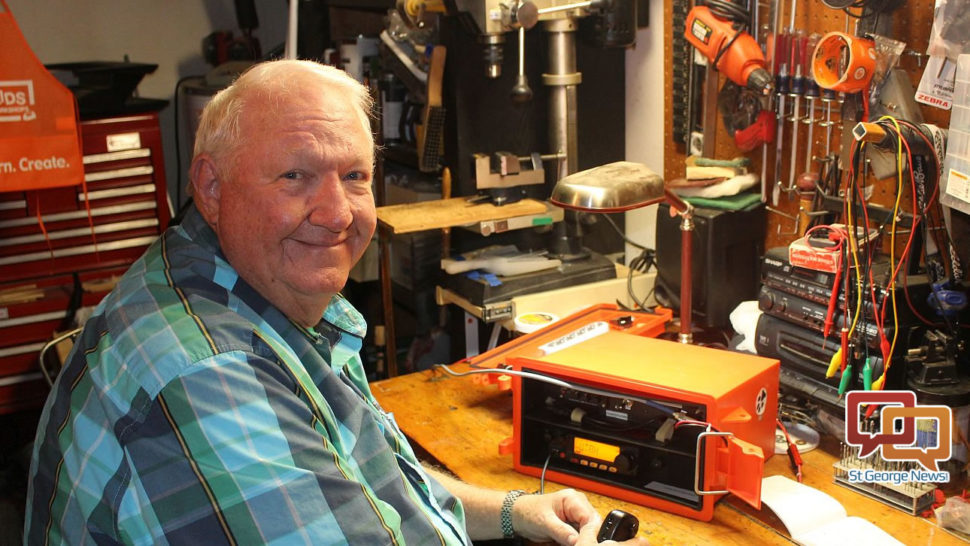Via St George News, July 6 2016. Written by Ric Wakeman. Original post here.

ST. GEORGE — In the age of cell phones and internet, amateur radio operators – also known as “ham operators” – are commonly looked upon as an anachronism, a throwback to earlier times. However, sometimes the old technology can be more reliable than the new high-tech gadgets and smartphones.
St. George ham operator Lynden Kendrick, who is a member of the Dixie Amateur Radio Club in St. George, the Community Emergency Response Team, the American Radio Relay League and Washington County Amateur Radio Emergency Services recently proved this point.
On the evening of June 26, Kendrick was talking on his radio to a fellow ham in Malad City, Idaho, on a radio system known locally as the “Intermountain Intertie,” a system of unmanned amateur radio repeaters linked up and down the state of Utah and into Nevada, Arizona, Montana, Wyoming and Idaho.
Kendrick said the ham in Malad City went to get a pencil, and another voice came on the radio asking for assistance. Kendrick answered the voice, asking how he could help. The ham on the other end introduced himself as Mike in Pahrump, Nevada.
Mike, who was later identified as Michael Hilbert of Moab, said the children’s ranch where he works was surrounded by fire. The Lovell Canyon Ranch, also known as the Torino Ranch, is a summer camp ranch designed for at-risk and special needs children. Hilbert is the assistant to Brett Torino, the founder and owner of Torino Ranch.
All children who had been camping at the ranch had been evacuated and there was only staff left at the ranch. Firefighters were controlling the blaze, but the power was out as were the telephones, internet and cell phone service. Hilbert asked Kendrick to call the local electric company and let them know.
Kendrick immediately found the phone number for Valley Electric in Pahrump and got on the telephone with them. With a bit of back-and-forth between the radio and telephone, Kendrick was able to have the power company dispatch someone to the ranch to restore power.
Kendrick got a text message later in the day from Hilbert.
“Mr Kendrick, thank you very much for your very gracious help today with the power company regarding the fire at our Lovell Canyon Ranch today,” said the text. “Sure was helpful as I saw the power co (sic) trucks responding as we were escorted out of the ranch by the police after our call today. If I can ever help you please reach out to me and I’ll give it my best like you did for me. Thank you. Mike.”
Better than a cell phone in an emergency
Cellular telephones are dependent on nearby cell towers to relay a telephone signal. The average cell phone transmits a very weak signal, usually about 1/10 watt to 1 watt. Even the inexpensive amateur handheld radios transmit with 5 watts of power, the mobile radios can run as high as 60 watts and amateurs can legally use up to 1,500 watts of power.
Amateur repeater stations will pick up a signal from a handheld and boost its power, usually from a high elevation area so the signal can transmit farther. The repeater Hilbert was using from his handheld radio was over 12 miles away. Southern Utah amateurs have a repeater on Utah Hill, which can allow for conversations to be held between Toquerville and the Las Vegas Speedway.
Amateur radio operators must obtain a license from the Federal Communications Commission and identify with their assigned call letters.
Not the first time amateurs have helped
This is not the first time that a local ham operator has been recognized for helping to save lives or property in remote areas.
Back in 2009, then-local resident Hal Whiting was traveling on the Arizona Strip near Poverty Mountain when he was flagged down by a man. Apparently a woman in his group had been injured when an ATV rolled over on her. No cellular service was available in the remote area.
Whiting was able to raise Mac Magee of Cane Beds, Arizona, on his ham radio. Magee and Whiting spent several hours coordinating the rescue between local officials and Whiting on scene.
“In these days of extensive cell phone service and coverage,” Magee said, “isn’t it satisfying to know that ham radio can still be of use for public service?”
